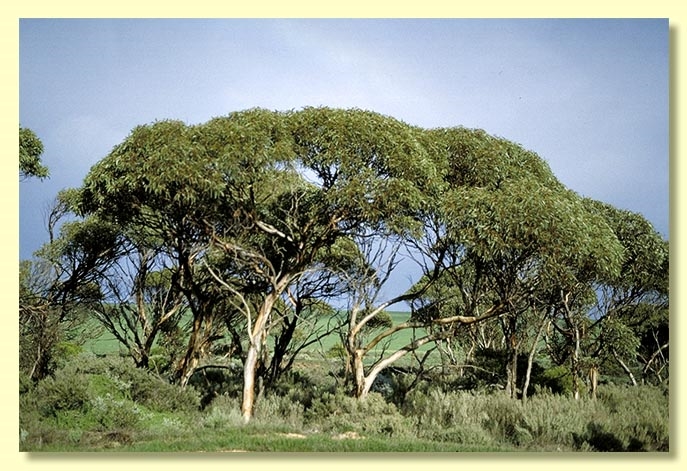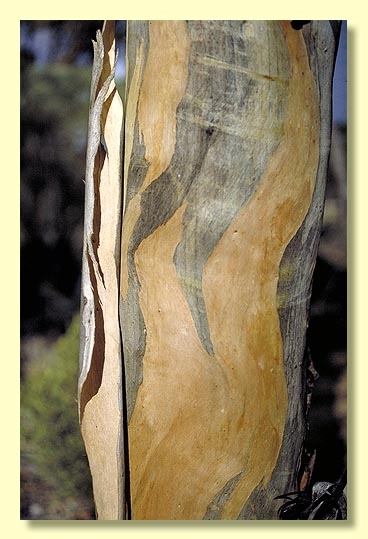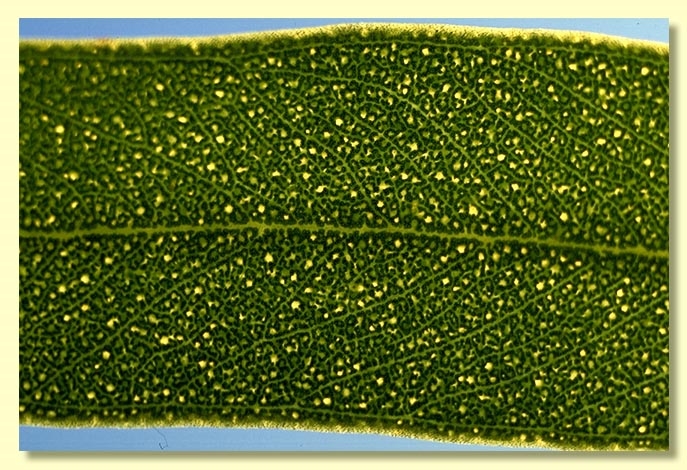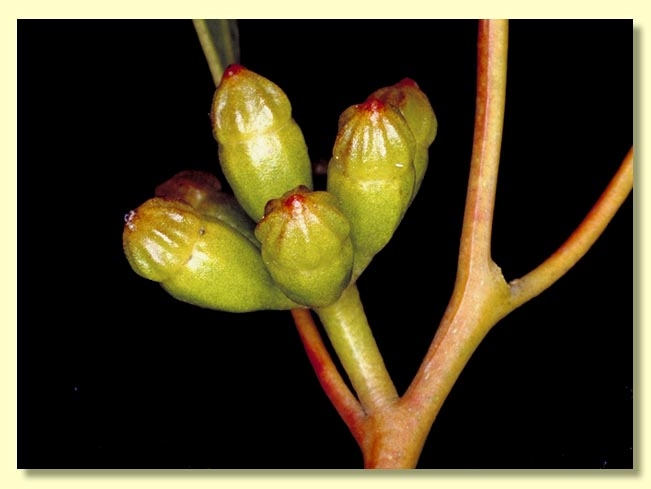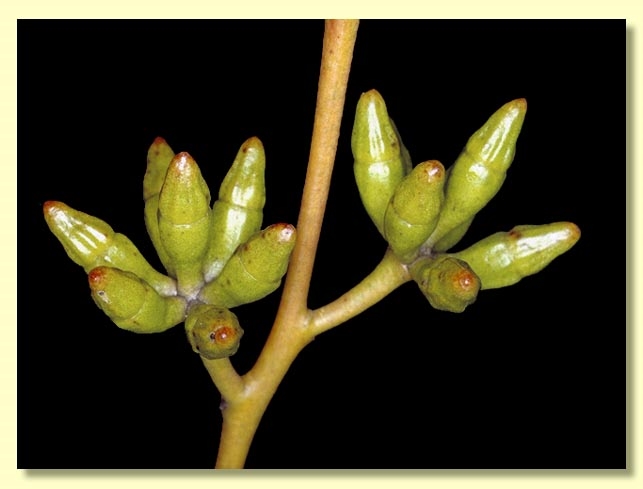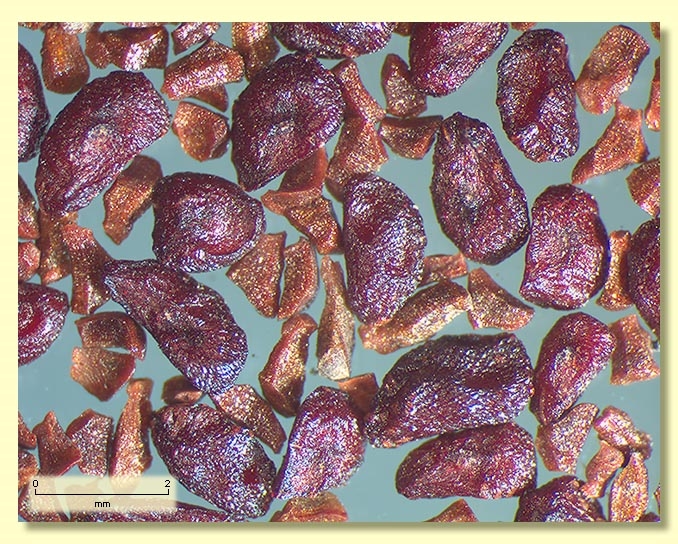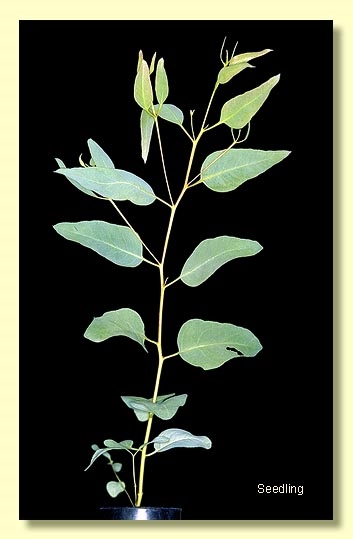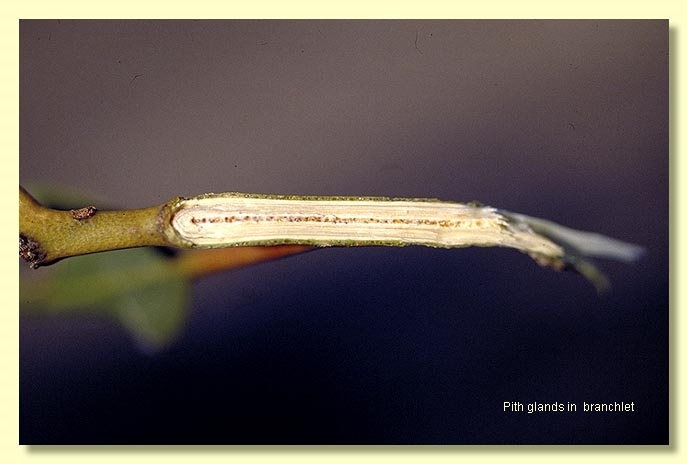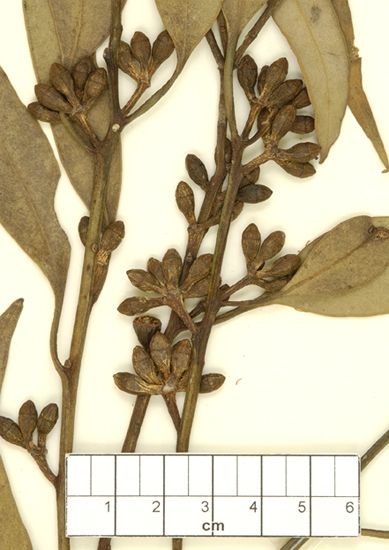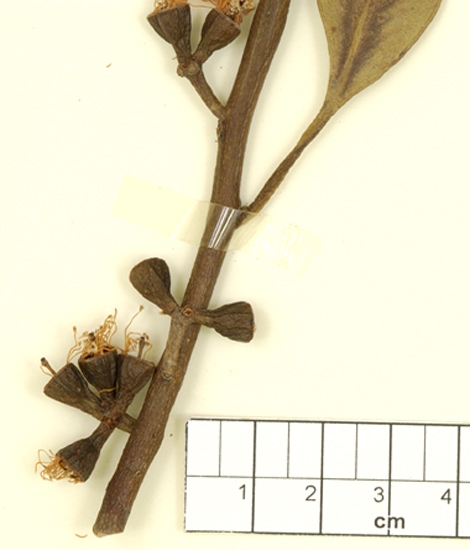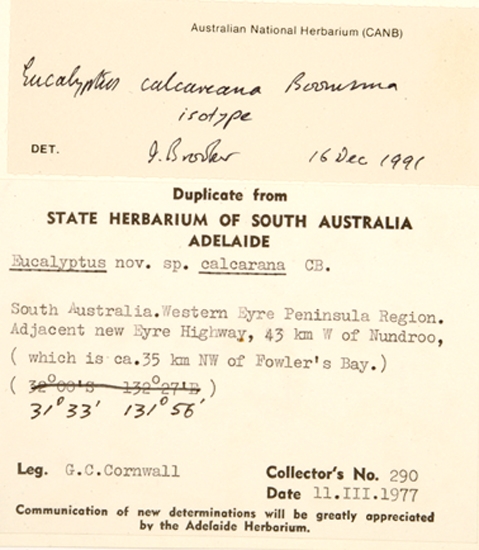Euclid - Online edition
Eucalyptus calcareana
Eucalyptus | Symphyomyrtus | Dumaria | Rufispermae
Bark smooth throughout, grey, cream, white and orange, shedding in ribbons.
Branchlets with oil glands in the pith.
Juvenile growth (coppice or field seedlings to 50 cm): stems square to rounded in cross-section; juvenile leaves always petiolate, alternate, ovate to broadly lanceolate, 6 to 10 cm long, 3.5–4.5 cm wide, base rounded to tapering, dull, blue-green, becoming glossy green as a sapling.
Adult leaves thickish, alternate, petioles 1–3 cm long; blade lanceolate to falcate, (6.5)7.5–14 cm long, 1–2.5 cm wide, base tapering to petiole, concolorous, at first bluish green soon maturing glossy, green, side-veins at an acute or wider angle to midrib, reticulation moderate to dense, intramarginal vein close to margin, oil glands numerous, intersectional.
Inflorescence axillary unbranched, peduncles 0.7–1.6 cm long, buds 7 or 9 per umbel, pedicels 0.1–0.5 cm long. Mature buds obovoid to cylindrical (0.7–1.3 cm long, 0.5–0.6 cm wide), scar present, operculum conical (0.25–0.6 cm long), radially striate, as wide the hypanthium, stamens inflexed, anthers cuboid to wedge-shaped, versatile, dehiscing by longitudinal slits, style long, stigma blunt, locules (3)4, the placentae each with 4 vertical ovule rows. Flowers creamy white.
Fruit pedicellate (pedicels 0.1–0.4 cm long), cupular to obconical, 0.5–1 cm long, 0.6–0.9 cm wide, slightly ribbed longitudinally or smooth, disc usually descending, rarely level, valves (3)4, just below rim level to slightly exserted.
Seeds reddish brown and glossy, 1.5–3.5 mm long, flattened ovoid and slightly angular in outline, often lacunose, dorsal surface smooth to shallowly reticulate, hilum ventral.
Cultivated seedlings (measured at ca node 10): cotyledons reniform; stems square in cross-section; leaves always petiolate, opposite for 3 to 5 nodes then alternate, broadly lanceolate to ovate, 9–12 cm long, 3–5 cm wide, dull, blue-green to green, coarse in appearance.
Flowering has been recorded in March and April.
Small trees or mallees often growing in pure stands, on limy red loams. Eucalyptus calcareana has a near coastal distribution both east and west of the Nullarbor Plain. In South Australia it is found from near Port Kenny to Nundroo and Yalata but is absent from the plain itself. Going west it reappears between Nullarbor roadhouse and the Western Australia border from where it has a scattered distribution on the elevated Hampton Tableland near Madura and as far west as about Caiguna. It is essentiaklly smooth-barked, has a glossy green-leaved crown of thick-textured leaves, and buds with operculum as wide as the base or slightly wider.
In the classification of Brooker (2000) Eucalyptus calcareana belongs in Eucalyptus subgenus Symphyomyrtus section Dumaria having these features: buds initially with two opercula the outer shed early, stamens strongly inflexed, ovules in 4 rows on the placentae and cotyledons reniform. Within section Dumaria the species belongs to a large sub-group of closely related species (series Rufispermae, 37 described species and subspecies) diagnosed by glandular pith in the branchlets, anthers cuboid to wedge-shaped and versatile, and by the reddish brown and glossy, flattish seeds which are unique to the series.
Eucalyptus calcareana has slightly larger fruit than its glossy-leaved close relatives E. pileata and E. phenax subsp. phenax both of which occur further to the south-east in higher rainfall country. The buds of E. pileata have the operculum obviously wider than the base of the bud, whilst E. phenax subsp. phenax has the operculum only as wide as the base of the bud.
Towards the eastern end of its distribution Eucalyptus calcareana may grade into other series Rufispermae species, viz. E. pileata, E. phenax and at the northern drier limits E. gypsophila. Around Ceduna, mallees otherwise matching E. calcareana may have some coarse ribbons of rough bark semi-persistent on the lower stem. Its nearest Western Australian relative is E. fraseri which occurs in the Balladonia and Fraser Range area. That species is a taller tree (lacking a lignotuber) with more robust buds and fruit.
Fine stands of Eucalyptus calcareana can be seen east of Yalata to Nundroo.

